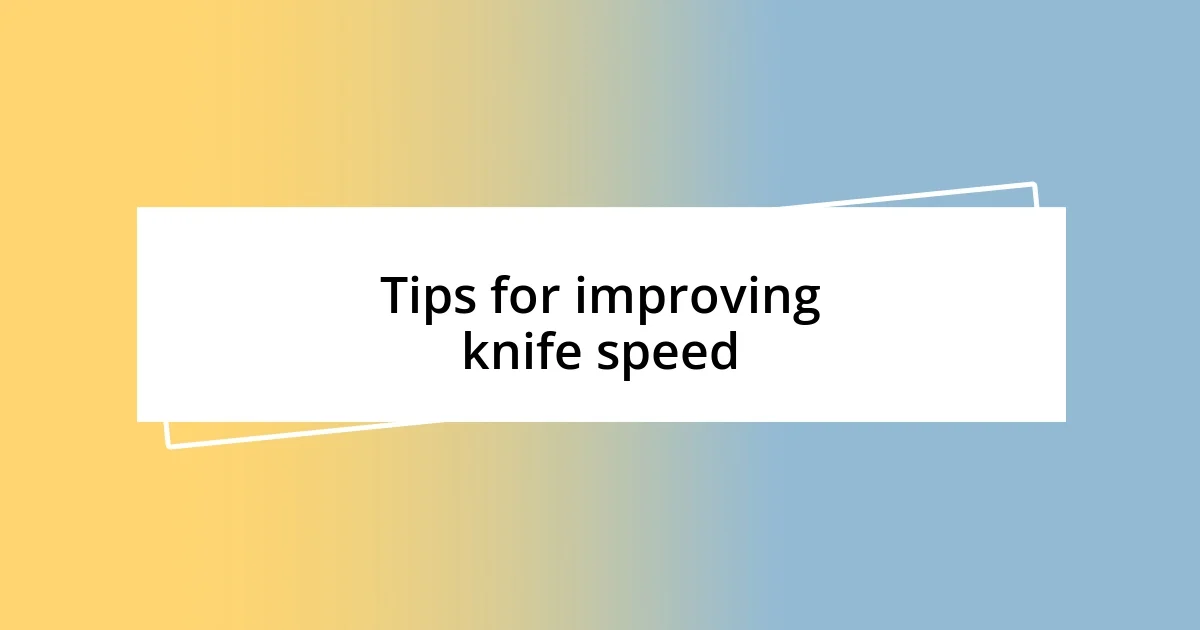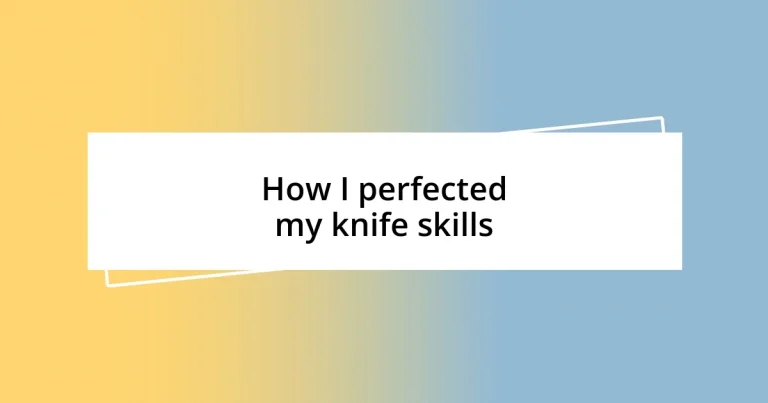Key takeaways:
- Mastering basic knife techniques, like the chopping motion and pinch grip, boosts confidence and enhances the cooking experience.
- Practicing advanced cutting methods such as chiffonade, brunoise, and mincing deepens the connection to food and improves culinary creativity.
- Proper knife maintenance and sharpening, along with focusing on body positioning, repetition, and using a well-balanced knife, significantly improve knife speed and safety.

Mastering basic knife techniques
When I first picked up a knife, I felt a mix of excitement and apprehension. The most fundamental technique I honed was the chopping motion. I remember a day in my kitchen when I practiced dicing onions. The rhythmic motion brought a sense of calm; each slice became a little victory. Isn’t it amazing how mastering such a simple technique can elevate your confidence?
Once I had the basic chops down, I delved into the art of the pinch grip, a game-changer for stability and control. It felt strange at first, but I quickly learned how it allowed me to maneuver the knife with precision, much to my delight. Have you ever experienced that moment when everything just clicks? It’s like discovering a hidden talent within yourself, and trust me, that feeling is addictive.
One of the most gratifying techniques I embraced was the rocking motion for herbs, not only because it’s efficient but also because it makes me feel like a professional chef. As I finely chopped basil one evening, the fragrance filled my kitchen, reminding me of my connection to the food I was preparing. Isn’t it incredible how mastering basic knife skills can transform not just your cooking but the entire cooking experience?

Practicing advanced cutting methods
Practicing advanced cutting methods has taken my skills to new heights, transforming my cooking experience. I vividly recall experimenting with the julienne technique one afternoon; at first, the thought of creating those perfect strips felt daunting. However, the satisfaction of seeing my vegetables neatly aligned was worth every moment of focus. It’s in those instances that the joy of cooking truly blossoms, don’t you think?
To further hone my skills, I concentrated on these advanced techniques:
- Chiffonade: I remember the first time I made a chiffonade of spinach; the skillful precision made my salad shine.
- Brunoise: Cutting vegetables into tiny cubes can be tedious, but once I saw how delightful they looked in a ratatouille, I embraced the challenge.
- Mincing: The art of mincing garlic took time to master—too much pressure made a mush, but finding that sweet spot was like unlocking a new level in a game.
- Batonnet: I practiced this technique with carrots, and serving them alongside a homemade dip transformed snack time into something special.
Each slice deepened my connection to the food, making me feel capable and creative in ways I never anticipated. The kitchen has become my playground, overflowing with inspiration and joy. Isn’t it fascinating how these techniques can elevate not just the dish, but the entire cooking journey?

Maintaining and sharpening your knives
Maintaining and sharpening your knives is essential for any serious home cook or chef. From my experience, dull knives can be frustrating and even dangerous. I recall a time when I was struggling to cut through a butternut squash; it was more work than necessary, and my frustration led to an unfortunate slip. That moment taught me the importance of a sharp blade—not only for ease but for safety, too.
Regular maintenance goes beyond just sharpening. I’ve found that cleaning and drying your knives properly can prevent rust and keep them in great shape. After each use, I take a moment to wipe down the blade and store it safely in a knife block or magnetic strip. Have you ever considered how small habits like these can prolong the life of your tools? I’ve noticed a significant difference since I adopted this practice.
When it comes to sharpening, I’ve explored various methods—whetstones, honing rods, and even electric sharpeners. Each tool serves a purpose, but my go-to remains the whetstone. The tactile experience of gliding the blade across the stone brings a sense of connection to the process. It’s meditative, almost like a ritual before I start cooking. What about you? Have you ever found yourself lost in a task that feels both productive and calming?
| Method | Description |
|---|---|
| Whetstone | Manual sharpening for a precise edge, requires practice and technique. |
| Honing Rod | Realigns the blade’s edge and is used frequently between sharpening. |
| Electric Sharpener | Convenient for quick sharpening, but may not deliver the same edge as manual methods. |

Tips for improving knife speed
To enhance your knife speed, I’ve found that repetition is key. When I first started, I dedicated a specific time each day to practice basic cuts like slicing and dicing. It felt a bit monotonous at first, but I gradually noticed how muscle memory kicked in. Have you experienced that too? The more I practiced, the more fluid and automatic my movements became, reducing hesitation and building confidence.
Another valuable tip is to focus on body positioning and grip. I remember adjusting my stance during a particularly hectic cooking session and realized how much smoother my cuts became. When I aligned my body to face the cutting board and maintained a firm grip on the handle, I felt more in control and could work quickly. It’s amazing how small adjustments can have such a significant impact, don’t you think?
Finally, I cannot stress enough the importance of a well-balanced knife. I once switched to a lighter knife and discovered a newfound speed in my chopping. The difference in weight helped me move with greater ease and less fatigue. Have you noticed how the right tool can change everything? Investing in a knife that feels good in your hand isn’t just a luxury; it’s a game-changer for your speed and efficiency in the kitchen.














